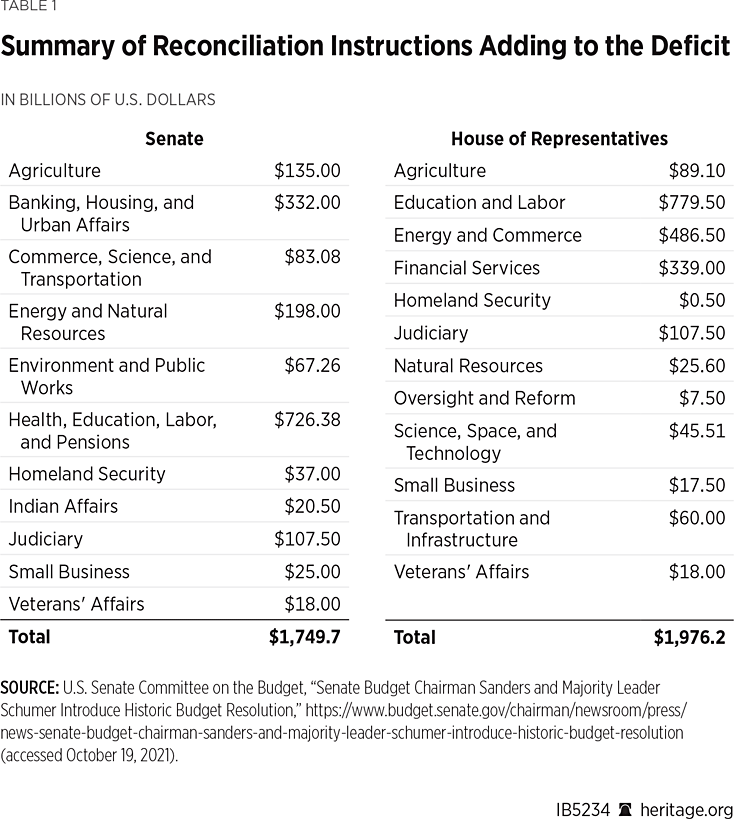Any given fiscal year may contain congressional consideration of a budget, reconciliation bill, debt limit increase, and appropriations measures, but it is rare to have Congress consider all of these in overlapping fashion in a short period of time. The goal of this report is to clearly outline what each of these items are, how they function, and how they are being used in the current congressional debates over the future of federal fiscal policy. This Issue Brief is meant to serve as a guide to congressional staff and the American public to help them navigate these events and to ensure that Congress remains accountable to the people whose lives and livelihoods could be impacted.
Budget Resolution
When Congress follows regular order, it first considers a budget resolution for the following fiscal year (FY) by April 15.REF Congress then considers appropriations legislation during the summer that would implement the discretionary spending levels in the budget resolution. Changes to mandatory spending and revenues can be made on an expedited basis through the reconciliation process.REF This allows for both the budgetary framework and the implementing legislation to have been enacted prior to the start of the next fiscal year (October 1).
However, Congress has seldom followed this process over the past decade. For example, the FY 2021 budget resolution was agreed to in both houses of Congress in February 2021, more than four months after the fiscal year had already begun.REF This delay occurred in order to give Congress access to the reconciliation instructions (discussed below), which were used to pass the $1.9 trillion American Rescue Plan.REF Similarly, the FY 2022 budget resolution was agreed to in late August 2021 after House consideration of FY 2022 appropriations bills.REF Here, too, this budget resolution was completed in order to gain access to the reconciliation instructions now being used for the $3.5 trillion tax and spending increase bill being assembled in the House.REF
Budget Reconciliation Instructions
The reconciliation process was intended to provide expedited consideration for legislation that would bring the current fiscal trajectory in line with the framework established in the budget resolution—to reconcile the two paths. These instructions, which are included in a budget resolution, give specific authorizing committees instructions to make changes to revenues or mandatory outlays.REF
Typically, as is the case with the FY 2022 budget resolution, the instructions are limits on each committee’s fiscal impact. Often, these limits will be ceilings on allowable deficit increases or floors for deficit reduction.
For example, the FY 2022 budget resolution would allow the Senate Agriculture Committee to increase the deficit by up to $135 billion and would allow the Senate Finance Committee (the Senate committee with jurisdiction over taxation) to decrease the deficit by at least $1 billion.REF The reconciliation instructions to the Senate Finance Committee—and identical instructions to the House Ways and Means Committee—would provide both with unchecked ability to increase taxes.

Each authorizing committee with instructions would then send its legislative package to its chamber’s budget committee. The budget committees then assemble all of the packages into a complete reconciliation bill. Each chamber’s bill is allowed to pass the Senate with a simple majority and bypass the filibuster. As such, the reconciliation procedure has given rise to the current trend of Congress passing “shell budgets” that are created only to gain access to the reconciliation instructions.
However, for such a bill to remain compliant with Senate rules and bypass the filibuster, it must meet certain requirements contained in the Byrd Rule,REF among which are prohibitions on legislative items that have no budgetary effect or only an incidental effect.REF
While some Members have attempted to include controversial changes to immigration or minimum wage laws in reconciliation bills, these changes would violate the Byrd Rule.REF
End of the Fiscal Year (September 30)
With the end of the federal fiscal year on September 30, discretionary funding (funding provided by an appropriations bill) for the U.S. federal government lapses unless new appropriations are enacted. Unlike reconciliation legislation, appropriations bills are subject to a 60-vote threshold in the Senate. Because of disagreements over spending levels and policy, the 12 regular appropriations bills are often not enacted before the start of the new fiscal year, which usually results in one or more continuing resolutions (CRs) that extend current spending levels for some additional time.
CRs can, and usually do, contain anomalies that go beyond simply extending the time frame of currently enacted budget authority levels.REF For example, most of the 94-page CR text originally introduced in the House on September 21, 2021,REF contained deviations from the exact text of the current law appropriations bills, as well as new emergency funding.
Though regular order envisions each of the 12 appropriations bills being considered and enacted separately, they are often rolled into one singular appropriations package, called an “omnibus,” or into groups of two or more appropriations bills, referred to as “minibuses.”
The currently enacted CR extends funding levels through December 3, 2021, requiring Congress to continue consideration of spending bills for the remainder of FY 2022.
Debt Limit
Congress will likely consider legislation related to the debt limit between now and the end of the calendar year. Though a debt-limit increase is commonly discussed, the debt limit has not been increased by a specific dollar amount since 2013, with one exception—the temporary $480 billion increase just enacted. Previously, Congress had voted to suspend the debt limit on eight separate occasions since 2013.REF During a period of suspension, Congress can add an unlimited amount to the national debt until a certain date, at which point the debt limit will be set at whatever level is necessary to accommodate the increase of the federal debt that occurred during the suspension.REF
The Treasury Department is able to engage in so-called extraordinary measures to delay the need to increase the debt limit while maintaining current annualized deficit levels.REF These measures are broad and somewhat undefined in scope. However, they notably include the prevention of the transfer of funds to certain federal trust funds and the withholding of issuance of non-marketable bonds or debt-servicing payments to certain federal trust funds.REF Prior to the recent $480 billion increase in the debt limit, these measures were expected to be exhausted by about the middle of October.REF Treasury gave a final estimate of October 18, 2021, as the exhaustion date.REF Once the debt limit is raised, Treasury will then make good on the unconventional actions taken as “extraordinary measures.” This also sets Treasury up to be able to engage in such measures again once the debt limit has been reached in the future.
Typically, reaching the debt limit has forced policymakers to address overspending. It led to the compromise that brought the Budget Control Act into law.REF However, Congress has used the reconciliation process four times to increase the debt limit by specific dollar amounts.REF These were each done through instructions placed into their respective budget resolutions and did not include suspensions of the debt limit. There is no firm precedent on whether Congress can suspend the debt limit in a reconciliation bill or alter it in a reconciliation bill without specific instructions regarding the matter.
The recently enacted $480 billion increase in the debt limit was intended to defer the issue of raising the debt limit until early or mid-December. (This includes both increased borrowing up to the new cap and the expected use of extraordinary measures.REF) This date would likely match the current CR’s expiration date of December 3, 2021.
Recommendations
As Congress continues to navigate these fiscal events during the fall, it should:
- Reject the Build Back Better reckless and burdensome tax and spending spree;
- Preserve vital discretionary spending provisions, such as pro-life protections, and reject efforts to irresponsibly increase non-defense discretionary spending;REF and
- Reject any blank check suspension of the debt limit and ensure that further increases of the debt limit are paired with reforms to achieve a spending trajectory toward balance and a cap on federal levels of taxation.REF
Conclusion
The procedures and processes outlined in this report were intended to provide for responsible and transparent congressional fiscal policy throughout a given fiscal year. They were not, as is now the case, intended to create a several-month-long period of confusion and opaque congressional action.
Richard Stern is a Senior Policy Analyst in the Grover M. Hermann Center for the Federal Budget, of the Institute for Economic Freedom, at The Heritage Foundation.



